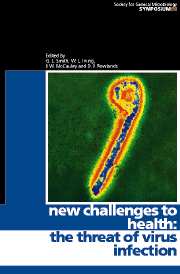Book contents
- Frontmatter
- Contents
- Contributors
- Editors' Preface
- 1 The viruses in our past, the viruses in our future
- 2 Dynamics and epidemiological impact of microparasites
- 3 The continuing threat of bunyaviruses and hantaviruses
- 4 Calicivirus, myxoma virus and the wild rabbit in Australia: a tale of three invasions
- 5 Potential of influenza A viruses to cause pandemics
- 6 The hepatitis viruses as emerging agents of infectious diseases
- 7 The emergence of human immunodeficiency viruses and AIDS
- 8 Morbilliviruses: dangers old and new
- 9 Structure–function analysis of prion protein
- 10 Endogenous retroviruses and xenotransplantation
- 11 Gammaherpesviral infections and neoplasia in immunocompromised populations
- 12 Structure and function of the proteins of Marburg and Ebola viruses
- 13 Epidemic dengue/dengue haemorrhagic fever as a public health problem in the 21st century
- 14 Borna disease virus – a threat for human mental health?
- 15 Antiviral drug development and the impact of drug resistance
- Index
12 - Structure and function of the proteins of Marburg and Ebola viruses
Published online by Cambridge University Press: 06 July 2010
- Frontmatter
- Contents
- Contributors
- Editors' Preface
- 1 The viruses in our past, the viruses in our future
- 2 Dynamics and epidemiological impact of microparasites
- 3 The continuing threat of bunyaviruses and hantaviruses
- 4 Calicivirus, myxoma virus and the wild rabbit in Australia: a tale of three invasions
- 5 Potential of influenza A viruses to cause pandemics
- 6 The hepatitis viruses as emerging agents of infectious diseases
- 7 The emergence of human immunodeficiency viruses and AIDS
- 8 Morbilliviruses: dangers old and new
- 9 Structure–function analysis of prion protein
- 10 Endogenous retroviruses and xenotransplantation
- 11 Gammaherpesviral infections and neoplasia in immunocompromised populations
- 12 Structure and function of the proteins of Marburg and Ebola viruses
- 13 Epidemic dengue/dengue haemorrhagic fever as a public health problem in the 21st century
- 14 Borna disease virus – a threat for human mental health?
- 15 Antiviral drug development and the impact of drug resistance
- Index
Summary
INTRODUCTION
Filoviruses cause fulminant haemorrhagic fever in humans and non-human primates, killing up to 90 % of the infected patients. Since the discovery of Marburg virus (MBGV) in 1967 and the emergence of Ebola virus (EBOV), its better known cousin, a few years later, these infections have therefore been a matter of high public and scientific concern. Although it is clear from the recorded history of filovirus outbreaks that all of them have so far been self-limiting and that the total number of human infections hitherto documented scarcely exceeds a thousand cases, EBOV by now ranges among the most ill-famed human viruses. For a long time, research on filoviruses has been impeded by their high pathogenicity, but with the advent of recombinant DNA technology our knowledge of the genome structures and the replication strategies of these agents has increased significantly.
PATHOPHYSIOLOGY OF FILOVIRUS INFECTIONS
The pathophysiological changes that make filovirus infections so devastating are just beginning to be unravelled. Pathogenesis in fatal infections in human and non-human primates is similar, suggesting the primate system is a reasonable model for studying filovirus haemorrhagic fever (Simpson et al., 1968; Murphy et al., 1971; Ellis et al., 1978; Fisher- Hoch et al., 1985; Ryabchikova et al., 1994). Clinical and biochemical findings support the anatomical observations of extensive liver involvement, renal damage, changes in vascular permeability, including endothelial damage, and activation of the clotting cascade. The visceral organ necrosis is a consequence of virus replication in parenchymal cells. However, no organ, not even the liver, shows sufficient damage to account for death.
Fluid distribution problems and platelet abnormalities are dominant clinical manifestations, reflecting damage of endothelial cells and decrease of platelets.
- Type
- Chapter
- Information
- New Challenges to HealthThe Threat of Virus Infection, pp. 233 - 246Publisher: Cambridge University PressPrint publication year: 2001



